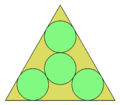Circle packing in an equilateral triangle: Difference between revisions
Kc kennylau (talk | contribs) No edit summary |
Kc kennylau (talk | contribs) No edit summary |
||
| Line 80: | Line 80: | ||
|- |
|- |
||
| 9 |
| 9 |
||
| 9.464... |
| <math>6 + 2 \sqrt {3}</math> = 9.464... |
||
|- |
|- |
||
| 10 |
| 10 |
||
| 9.464... |
| <math>6 + 2 \sqrt {3}</math> = 9.464... |
||
|- |
|- |
||
| 11 |
| 11 |
||
| Line 89: | Line 89: | ||
|- |
|- |
||
| 12 |
| 12 |
||
| 10.928... |
| <math>4 + 4 \sqrt {3}</math> = 10.928... |
||
|- |
|- |
||
| 13 |
| 13 |
||
| Line 95: | Line 95: | ||
|- |
|- |
||
| 14 |
| 14 |
||
| 11.464... |
| <math>8 + 2 \sqrt {3}</math> = 11.464... |
||
|- |
|- |
||
| 15 |
| 15 |
||
| 11.464... |
| <math>8 + 2 \sqrt {3}</math> = 11.464... |
||
|} |
|} |
||
Revision as of 12:45, 17 December 2016
Circle packing in an equilateral triangle is a packing problem in discrete mathematics where the objective is to pack n unit circles into the smallest possible equilateral triangle. Optimal solutions are known for n < 13 and for any triangular number of circles, and conjectures are available for n < 28.[1][2][3]
A conjecture of Paul Erdős and Norman Oler states that, if n is a triangular number, then the optimal packings of n − 1 and of n circles have the same side length: that is, according to the conjecture, an optimal packing for n − 1 circles can be found by removing any single circle from the optimal hexagonal packing of n circles.[4] This conjecture is now known to be true for n ≤ 15.[5]
Minimum solutions for the side length of the triangle:[1]
A closely related problem is to cover the equilateral triangle with a given number of circles, having as small a radius as possible.[6]
See also
- Circle packing in an isosceles right triangle
- Malfatti circles, a construction giving the optimal solution for three circles in an equilateral triangle
References
- ^ a b Melissen, Hans (1993), "Densest packings of congruent circles in an equilateral triangle", The American Mathematical Monthly, 100 (10): 916–925, doi:10.2307/2324212, MR 1252928.
- ^ Melissen, J. B. M.; Schuur, P. C. (1995), "Packing 16, 17 or 18 circles in an equilateral triangle", Discrete Mathematics, 145 (1–3): 333–342, doi:10.1016/0012-365X(95)90139-C, MR 1356610.
- ^ Graham, R. L.; Lubachevsky, B. D. (1995), "Dense packings of equal disks in an equilateral triangle: from 22 to 34 and beyond", Electronic Journal of Combinatorics, 2: Article 1, approx. 39 pp. (electronic), MR 1309122.
- ^ Oler, Norman (1961), "A finite packing problem", Canadian Mathematical Bulletin, 4: 153–155, doi:10.4153/CMB-1961-018-7, MR 0133065.
- ^ Payan, Charles (1997), "Empilement de cercles égaux dans un triangle équilatéral. À propos d'une conjecture d'Erdős-Oler", Discrete Mathematics (in French), 165/166: 555–565, doi:10.1016/S0012-365X(96)00201-4, MR 1439300.
- ^ Nurmela, Kari J. (2000), "Conjecturally optimal coverings of an equilateral triangle with up to 36 equal circles", Experimental Mathematics, 9 (2): 241–250, doi:10.1080/10586458.2000.10504649, MR 1780209.











